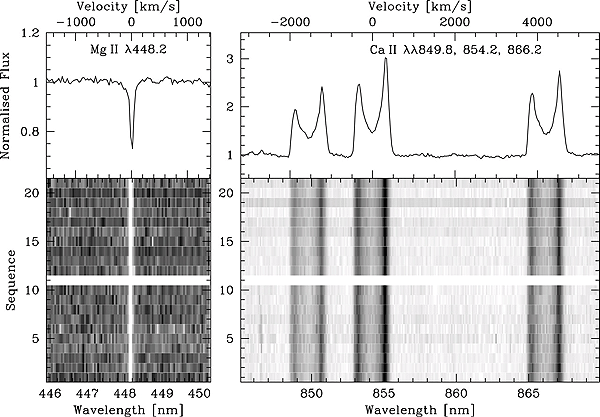 | |||
|
| Home > Public Information > Scientific Highlights > 2006 > A Gaseous Metal Disk Around a White Dwarf |
A Gaseous Metal Disk Around a White Dwarf | ||
|
WHT+ISIS, INT+WFC
The destiny of planetary systems through the late evolution of their host stars is very uncertain. Recently a team of astronomers from the University of Warwick found a metal-rich gas disk around a moderately hot and young white dwarf,
and claim that the tidal disruption of an asteroid is the most likely origin. They identified SDSS J122859.93+104032.9 (henceforth SDSS 1228+1040) as a moderately hot 0.77 solar-mass white dwarf, but noted very unusual emission lines of the Ca II 850- to 866-nm triplet, as well as weaker emission lines of Fe II at 502 and 517 nm. The line profiles of the Ca II triplet display a distinct double-peaked morphology, which is the hallmark of a gaseous, rotating disk. Time-resolved spectroscopy and photometry do not reveal any radial velocity or brightness variations. These data exclude the possibility that SDSS 1228+1040 is an interacting white dwarf binary, in which an accretion disk around the white dwarf forms from material supplied by a nearby companion star. Furthermore, the absence of Balmer and helium emission lines implies that the gaseous disk around SDSS 1228+1040 must be extremely deficient in volatile elements, which independently rules out an interacting binary nature for this object. A dynamical model of the double-peaked emission lines constrains the outer disk radius to just 1.2 solar radii. A possible origin of such dust disks is the tidal disruption of either comets or asteroids. Asteroids appear to be more likely candidates because they can explain the large amount of metals accreted by the white dwarfs from the dusty environment, as well as the absence of hydrogen or helium.
As the main-sequence stars hosting planetary systems evolve through the red-giant stage, they swell up and destroy planets and asteroids out to many hundred solar radii. The white dwarf mass implies a relatively massive main-sequence progenitor of ~4 to 5 solar masses, which will have expanded to a radius of ~1000 solar radii. It is therefore impossible that the material making up the present-day disk has survived the giant phase at its current location; it must instead have been brought inward from outside a distance of 1000 solar radii. Planetary debris that migrated outward to large radii during the giant phase is expected to have relatively stable orbits unless perturbed by larger-mass objects. A likely scenario is therefore that one or more planets that survived the evolution of the progenitor destabilized the orbit of an asteroid sometime after the end of the planetary nebula phase. When it gets close enough to the compact star, the asteroid is tidally disrupted, forming a disk of metal-rich debris, which subsequently sublimates in the radiation field of the white dwarf. The radius derived from the dynamical model is compatible with the tidal disruption radius for a rocky asteroid. Although the detection of asteroid debris around SDSS 1228+1040 represents a possible link to the existence of planetary systems around their main-sequence progenitor stars, modeling the excess infrared luminosity provides no direct information on the geometric location and extension of the dust, impeding a more detailed understanding of the nature and origin of the circumstellar material. But certainly the infrared excess found around metal-polluted white dwarfs hotter than 15,000K suggests that the radiation field of these hot white dwarfs causes sublimation of a dust disk and the case of SDSS 1228+1040 demonstrates that planetary debris material can be detected around younger and hotter white dwarfs in the form of gaseous disks. Furthermore, the detection of a metal-rich debris disk around this relatively massive white dwarf indicates that the formation of planetary systems can take place also around short-lived massive stars. References:
|
| Top | Back |
|



